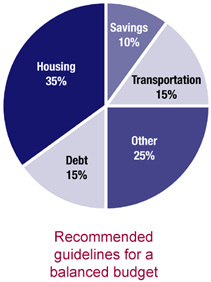Budgeting is more than subtraction, and affordability is more than getting pre-approved.
Did you know that based on your income, there are guidelines that can help you understand what you can reasonably afford? This is called living within your means. And, when you know what those are, living within them is much easier!
A well-designed, realistic spending plan is the most important step to take in your journey to reach your financial goals.
Click here for a worksheet to help you stay within the balanced budget guidelines.

Developing Your Own Spending Plan
The math that lies at the root of a strong spending plan is simple: The amount of money going out must always be less than, or equal to, the amount of money coming in. Most of us have a fairly good sense of how much we bring home each month through our paychecks and perhaps earnings on savings and investments. Money going out, however, may be a bit fuzzier. The checks we write and the purchases made on credit cards are easy enough to track, but cash may seem simply to disappear. As a result, there are gaps in the spending plan.
Understanding and flexibility in your spending habits is the key to successful budgeting. Once you’ve tracked your spending, then you are in a position to make an educated decision whether to continue spending as you have, or to make changes in order to more readily reach your financial goals.
Wonder where all of your money goes?
For one week, record all of your expenses no matter how small. At the end of the week, you'll have a clear idea of where those extra dollars could be hiding. In the future, you can use the funds you currently fritter away to increase savings, pay off bills, or buy something special.
Pay Yourself First!
Save and invest 5-10% of your gross annual income. Of course, for most of us, this is easier said than done. If you're currently living from paycheck to paycheck without seeing an opportunity to get ahead, begin by creating a solid spending plan after tracking all of your monthly expenses.
How to Save
Most people agree that saving is a good thing, but they find it difficult to do. Believe it or not, it IS possible to save for short-term and long-term goals, emergencies and even retirement. The choice is up to you!
The 70-20-10 Rule
One easy way to save is to follow the 70-20-10 Rule. Divide your income in the following manner:
- 70% for living expenses (rent, food, clothing, gasoline)
- 20% for savings
- 10% for retirement (IRA, 401(k), company pension)
- 5% for emergencies (car repairs, medical expenses, unemployment)
- 5% for specific goals (vacation, car, school tuition, a new computer)
- 10% for debt (student loans, car payments, credit cards)
If you exceed these percentages in any category, reduce your spending in the other areas. For example, if you spend 75% of your income on living expenses, reduce the amount you put into your savings by 5%. If you want to put more money into your savings, you must reduce your living expenses and/or decrease your debt.